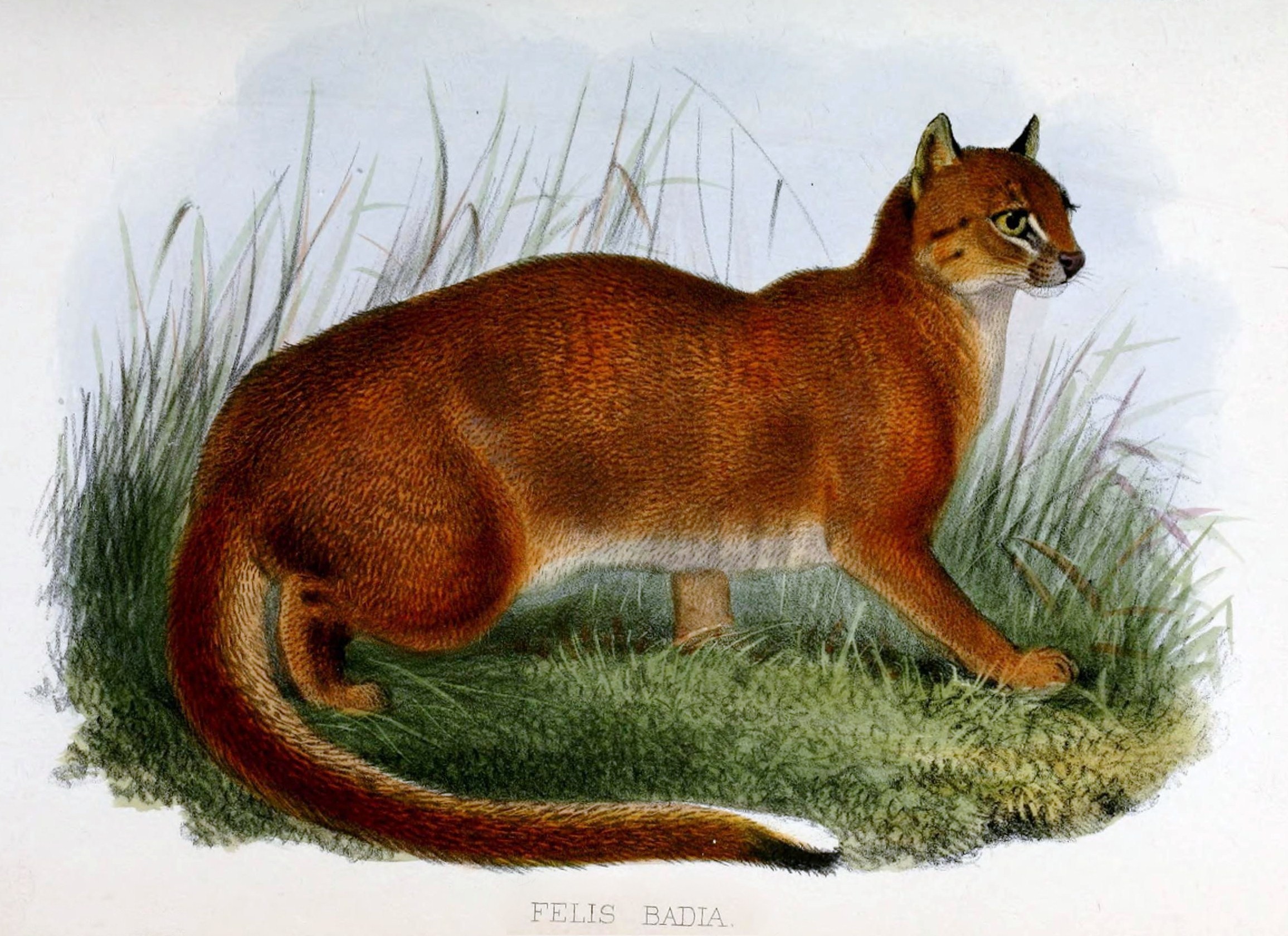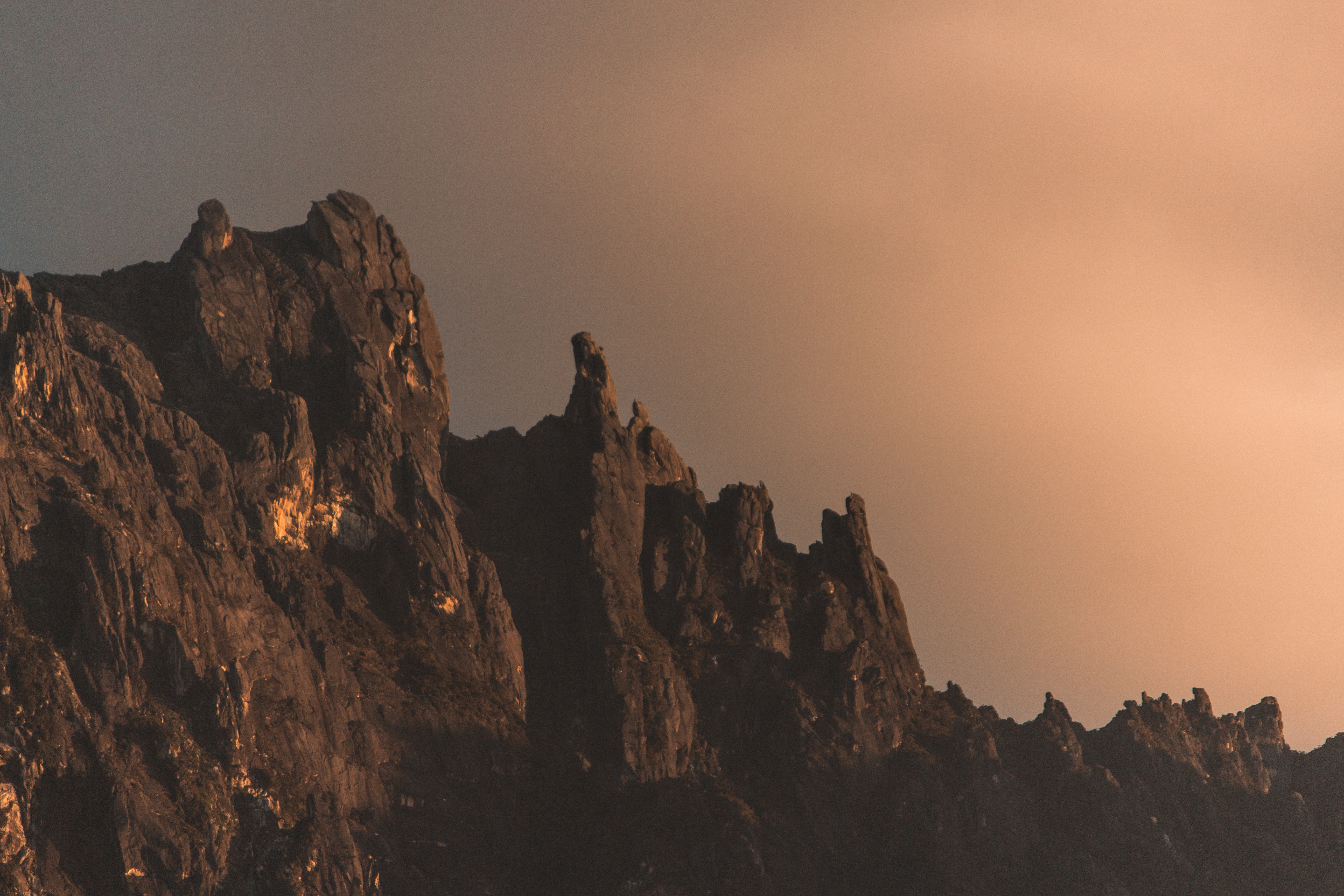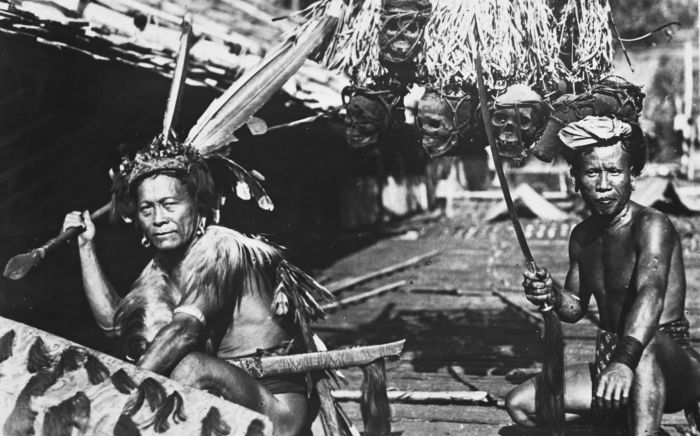|
Bay Cat
The bay cat (''Catopuma badia''), also known as the Bornean bay cat, is a small wild cat endemic to the island of Borneo that appears to be relatively rare compared to sympatric wild cats, based on the paucity of historical, as well as recent records. Since 2002, it has been listed as Endangered on the IUCN Red List because it is estimated that fewer than 2,500 mature individuals exist, and that the population declined in the past. The bay cat has been recorded as rare and seems to occur at relatively low density, even in pristine habitat. Taxonomy and evolution ''Felis badia'' was the scientific name proposed by John Edward Gray in 1874, who first described a bay cat skin and skull collected by Alfred Russel Wallace in 1856 in Sarawak. This cat was first thought to be a kitten of an Asian golden cat. In 1932, Reginald Innes Pocock placed the species in the monotypic genus ''Badiofelis''. In 1978, it was placed in the genus ''Catopuma''. Tissue and blood samples were acquired on ... [...More Info...] [...Related Items...] OR: [Wikipedia] [Google] [Baidu] |
John Edward Gray
John Edward Gray, FRS (12 February 1800 – 7 March 1875) was a British zoologist. He was the elder brother of zoologist George Robert Gray and son of the pharmacologist and botanist Samuel Frederick Gray (1766–1828). The same is used for a zoological name. Gray was keeper of zoology at the British Museum in London from 1840 until Christmas 1874, before the natural history holdings were split off to the Natural History Museum. He published several catalogues of the museum collections that included comprehensive discussions of animal groups and descriptions of new species. He improved the zoological collections to make them amongst the best in the world. Biography Gray was born in Walsall, but his family soon moved to London, where Gray studied medicine. He assisted his father in writing ''The Natural Arrangement of British Plants'' (1821). After being blackballed by the Linnean Society of London, Gray shifted his interest from botany to zoology. He began his zoologica ... [...More Info...] [...Related Items...] OR: [Wikipedia] [Google] [Baidu] |
Marbled Cat
The marbled cat (''Pardofelis marmorata'') is a small wild cat native from the eastern Himalayas to Southeast Asia, where it inhabits forests up to an elevation of . As it is present in a large range, it has been listed as Near Threatened on the IUCN Red List since 2015. The marbled cat is closely related to the Asian golden cat (''Catopuma temminckii'') and the bay cat (''C. badia''), all of which diverged from other felids about 9.4 million years ago. Characteristics The marbled cat is similar in size to a domestic cat, but has rounded ears and a very long tail that is as long as the cat's head and body. The ground colour of its long fur varies from brownish-grey to ochreous brown above and greyish to buff below. It is patterned with black stripes on the short and round head, on the neck and back. On the tail, limbs and underbelly it has solid spots. On the flanks it has irregular dark-edged blotches that fuse to dark areas and look like a 'marbled' pattern. Its paws are webbed ... [...More Info...] [...Related Items...] OR: [Wikipedia] [Google] [Baidu] |
Limestone
Limestone ( calcium carbonate ) is a type of carbonate sedimentary rock which is the main source of the material lime. It is composed mostly of the minerals calcite and aragonite, which are different crystal forms of . Limestone forms when these minerals precipitate out of water containing dissolved calcium. This can take place through both biological and nonbiological processes, though biological processes, such as the accumulation of corals and shells in the sea, have likely been more important for the last 540 million years. Limestone often contains fossils which provide scientists with information on ancient environments and on the evolution of life. About 20% to 25% of sedimentary rock is carbonate rock, and most of this is limestone. The remaining carbonate rock is mostly dolomite, a closely related rock, which contains a high percentage of the mineral dolomite, . ''Magnesian limestone'' is an obsolete and poorly-defined term used variously for dolomite, for limes ... [...More Info...] [...Related Items...] OR: [Wikipedia] [Google] [Baidu] |
Tropical Forest
Tropical forests (a.k.a. jungle) are forested landscapes in tropical regions: ''i.e.'' land areas approximately bounded by the tropic of Cancer and Capricorn, but possibly affected by other factors such as prevailing winds. Some tropical forest types are difficult to categorise. While forests in temperate areas are readily categorised on the basis of tree canopy density, such schemes do not work well in tropical forests. There is no single scheme that defines what a forest is, in tropical regions or elsewhere.Anatoly Shvidenko, Charles Victor Barber, Reidar Persson et al. 2005 "Millennium Ecosystem Assessment." Ecosystems and human wellbeing: a framework for assessment Washington, DC: Island Press Because of these difficulties, information on the extent of tropical forests varies between sources. However, tropical forests are extensive, making up just under half the world's forests. The tropical domain has the largest proportion of the world’s forests (45 percent), followed by ... [...More Info...] [...Related Items...] OR: [Wikipedia] [Google] [Baidu] |
Mount Kinabalu
Mount Kinabalu ( ms, Gunung Kinabalu, Dusun language, Dusun: ''Gayo Ngaran or Nulu Nabalu'') is the highest mountain in Borneo and Malaysia. With an elevation of , it is List of islands by highest point, third-highest peak of an island on Earth, and List of mountain peaks by prominence, 20th most prominent mountain in the world by topographic prominence. The mountain is located in Ranau District, Ranau district, West Coast Division of Sabah, Malaysia. It is protected as Kinabalu Park, a World Heritage Site. In 1997, a re-survey using satellite technology established its summit (known as Low's Peak) height at above sea level, which is some less than the previously thought and hitherto published figure of .Anthea Phillipps, Phillipps, A. & Francis Liew, F. Liew 2000. ''Globetrotter Visitor's Guide – Kinabalu Park''. New Holland Publishers (UK) Ltd. The mountain and its surroundings are among the most important biological sites in the world, with between 5,000 and 6,000 speci ... [...More Info...] [...Related Items...] OR: [Wikipedia] [Google] [Baidu] |
Dipterocarp
Dipterocarpaceae is a family of 16 genera and about 695 known species of mainly tropical lowland rainforest trees. The family name, from the type genus ''Dipterocarpus'', is derived from Greek (''di'' = two, ''pteron'' = wing and ''karpos'' = fruit) and refers to the two-winged fruit. The largest genera are ''Shorea'' (196 species), ''Hopea'' (104 species), ''Dipterocarpus'' (70 species), and ''Vatica'' (65 species).Ashton, P.S. Dipterocarpaceae. In ''Tree Flora of Sabah and Sarawak,'' Volume 5, 2004. Soepadmo, E., Saw, L. G. and Chung, R. C. K. eds. Government of Malaysia, Kuala Lumpur, Malaysia. Many are large forest-emergent species, typically reaching heights of 40–70 m, some even over 80 m (in the genera ''Dryobalanops'', ''Hopea'' and ''Shorea''), with the tallest known living specimen (''Shorea faguetiana'') 93.0 m tall. The species of this family are of major importance in the timber trade. Their distribution is pantropical, from northern South America to Africa, the Sey ... [...More Info...] [...Related Items...] OR: [Wikipedia] [Google] [Baidu] |
Swamp Forests
Freshwater swamp forests, or flooded forests, are forests which are inundated with freshwater, either permanently or seasonally. They normally occur along the lower reaches of rivers and around freshwater lakes. Freshwater swamp forests are found in a range of climate zones, from boreal through temperate and subtropical to tropical. In the Amazon Basin of Brazil, a seasonally flooded forest is known as a ''várzea'', and refers to a whitewater-inundated forest. ''Igapó'' refers to blackwater-inundated forest. Peat swamp forests are swamp forests where waterlogged soils prevent woody debris from fully decomposing, which over time creates a thick layer of acidic peat. Freshwater swamp forest ecoregions Afrotropic * Eastern Congolian swamp forests (Democratic Republic of the Congo) * Niger Delta swamp forests (Nigeria) * Western Congolian swamp forests (Republic of the Congo, Democratic Republic of the Congo). Australasia * Northern New Guinea lowland rain and freshwater ... [...More Info...] [...Related Items...] OR: [Wikipedia] [Google] [Baidu] |
West Kalimantan
West Kalimantan ( id, Kalimantan Barat) is a province of Indonesia. It is one of five Indonesian provinces comprising Kalimantan, the Indonesian part of the island of Borneo. Its capital city is Pontianak, Indonesia, Pontianak. The province has an area of 147,307 km2, and had a population of 4,395,983 at the 2010 CensusBiro Pusat Statistik, Jakarta, 2011. and 5,414,390 at the 2020 Census. Ethnic groups include the Dayak people, Dayak, Malay people, Malay, Chinese Indonesians, Chinese, Javanese people, Javanese, Bugis, and Madurese people, Madurese. The borders of West Kalimantan roughly trace the mountain ranges surrounding the vast watershed of the Kapuas River, which drains most of the province. The province shares land borders with Central Kalimantan to the southeast, East Kalimantan to the east, and the Malaysian territory of Sarawak to the north. West Kalimantan is an area that could be dubbed "The Province of a Thousand Rivers". The nickname is aligned with the geograp ... [...More Info...] [...Related Items...] OR: [Wikipedia] [Google] [Baidu] |
Kapuas River
The Kapuas River (or Kapoeas River) is a river in the Indonesian part of Borneo island, at the geographic center of Maritime Southeast Asia. At in length, it is the longest river in the island of Borneo and the longest river of IndonesiaMacKinnon, p. 133 and one of the world's longest island rivers. It originates in the Müller mountain range at the center of the island and flows west into the South China Sea creating an extended marshy delta. The delta is located west-southwest of Pontianak, the capital of the West Kalimantan province.Kapuas River Encyclopædia Britannica on-line This Kapuas River should be distinguished from another , which starts on the ot ... [...More Info...] [...Related Items...] OR: [Wikipedia] [Google] [Baidu] |
Gunung Palung National Park
Mount Palung National Park ( id, Taman Nasional Gunung Palung) lies on the island of Borneo, in the Indonesian province of West Kalimantan, north of Ketapang and east of Sukadana. History Mount Palung was first protected in 1937 as a forest nature reserve covering . In 1981, the size was increased to and its status raised to a wildlife reserve, and on 24 March 1990 the area became a national park. Geography The park is notable for its diversity of habitat types, ranging from mangrove and freshwater swamp forest, to lowland alluvial (empran bench) forest, to montane forest, and for its diversity of wildlife. It is one of only a handful of parks in the world where orangutans can be seen in the wild. A research station (Cabang Panti) was established at the western foot of the main Mount Palung mountains in 1985, and is owned and operated by the park management authority.Researchthere has contributed significantly to our understanding of Borneo forest biology. Illegal, non-me ... [...More Info...] [...Related Items...] OR: [Wikipedia] [Google] [Baidu] |
Indonesia
Indonesia, officially the Republic of Indonesia, is a country in Southeast Asia and Oceania between the Indian and Pacific oceans. It consists of over 17,000 islands, including Sumatra, Java, Sulawesi, and parts of Borneo and New Guinea. Indonesia is the world's largest archipelagic state and the 14th-largest country by area, at . With over 275 million people, Indonesia is the world's fourth-most populous country and the most populous Muslim-majority country. Java, the world's most populous island, is home to more than half of the country's population. Indonesia is a presidential republic with an elected legislature. It has 38 provinces, of which nine have special status. The country's capital, Jakarta, is the world's second-most populous urban area. Indonesia shares land borders with Papua New Guinea, East Timor, and the eastern part of Malaysia, as well as maritime borders with Singapore, Vietnam, Thailand, the Philippines, Australia, Palau, and India ... [...More Info...] [...Related Items...] OR: [Wikipedia] [Google] [Baidu] |
Sarawak
Sarawak (; ) is a States and federal territories of Malaysia, state of Malaysia. The largest among the 13 states, with an area almost equal to that of Peninsular Malaysia, Sarawak is located in northwest Borneo Island, and is bordered by the Malaysian state of Sabah to the northeast, Kalimantan (the Indonesian portion of Borneo) to the south, and Brunei in the north. The capital city, Kuching, is the largest city in Sarawak, the economic centre of the state, and the seat of the Sarawak state government. Other cities and towns in Sarawak include Miri, Malaysia, Miri, Sibu, and Bintulu. As of 2021, the population of Sarawak was estimated to be around 2.45 million. Sarawak has an equatorial climate with tropical rainforests and abundant animal and plant species. It has several prominent cave systems at Gunung Mulu National Park. Rajang River is the longest river in Malaysia; Bakun Dam, one of the largest dams in Southeast Asia, is located on one of its tributaries, the Balui River ... [...More Info...] [...Related Items...] OR: [Wikipedia] [Google] [Baidu] |







